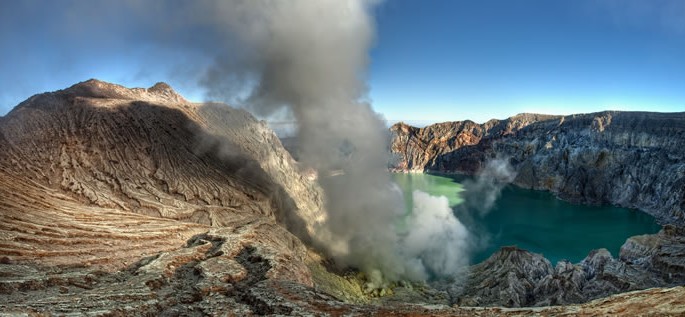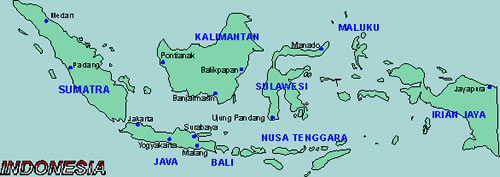
Javanese
Javanese is a member of the Malayo-Polynesian branch of the Austronesian language family. Its closest relatives are Malay, Sunda, Madura, and Bali. It is the second most spoken Austronesian language after Indonesian, and the fourteenth most widely spoken language in the world. Javanese is considered to be one of the world’s classical languages, with a literary tradition that goes back over a thousand years. The oldest inscription in Javanese dates back to 804 AD.
Status
Javanese is the spoken language of over 75 million people in the central and eastern parts of the island of Java, in Indonesia (Ethnologue). It is also spoken in Malaysia, the Netherlands, and in Singapore (Ethnologue). In addition, there are Javanese settlements in Papua, Sulawesi, Maluku, Kalimantan, and Sumatra.
Although it not an official language of Indonesia, Javanese is recognized as a regional language in three provinces of Java with the largest concentrations of speakers of Javanese, namely, Central Java, East Java, and Yogyakarta where it is taught in schools, used in religious practice and in electronic and print media. Javanese is also used as a literary language in Madura, Bali, Lombok, and West Java. Javanese is used as a spoken and communal language in suburban and rural areas of Java, and in some parts the urban communities. Indonesian is used in media such as TV, newspapers and magazines, while Javanese is used only on certain programs on the radio or television and in certain newspaper columns.
Dialects
There are three main dialects of Javanese that are more or less mutually intelligible. Each consists of sub-dialects. The principal differences among dialects have to do with pronunciation, and, to a lesser extent, with vocabulary.
- Western Javanese is spoken along the northern coast of West Java. It is influenced by Sunda.
- Central Javanese is considered to be the prestige dialect, and serves as a basis for standard Javanese.
- Eastern Javanese is spoken across the majority of the East Java province. It is influenced by Madura.
Structure
Sound system
A typical syllable in Javanese consists of a nasal consonant (/m/, /n/, /ng/) + an approximant (/y/, /r/, /l/, /w/) + vowel + consonant. Only voiceless stops can occur at the end of syllables in some dialects.
Vowels
Like Malay and Indonesian, Javanese has 6 vowel phonemes, i.e., sounds that make a difference in word meaning.
| Close |
i
|
u
|
|
| Mid |
e
|
ə
|
o
|
| Open |
a
|
- /ə/ = a in about
Consonants
An interesting feature of Javanese phonology are retroflex consonants which are articulated with the tip of the tongue curled up and back so the bottom of the tip touches the roof of the mouth. Some scholars believe that these consonants are the result of the influence of Indo-Aryan languages. Consonants in parentheses occur only in loanwords.
| Alveolar | Postalveolar | Retroflex | |||||||
|---|---|---|---|---|---|---|---|---|---|
| Stops | voiceless |
p
|
t
|
ʈ
|
k
|
ʔ
|
|||
| voiced |
b
|
d
|
xx |
ɖ
|
….xxx |
g
|
|||
| Fricatives | voiceless |
s
|
(ʃ)
|
(ʂ)
|
h
|
||||
| Affricates | voiceless |
tʃ
|
|||||||
| voiced |
dʒ
|
||||||||
| Nasals |
m
|
n
|
(ɳ)
|
ɲ
|
ŋ
|
||||
| Laterals |
l
|
x | |||||||
| Trill |
r
|
||||||||
| Approximants |
w
|
j
|
|||||||
- /ʈ, ɖ, ʂ, ɳ/ are retroflex consonants with no equivalents in English.
- /ʔ/ = sound between the vowels in uh-oh
- /ʃ/ = sh in shop
- /tʃ/ = ch in chop
- /dʒ/ = j in job
- /ɲ/ = first n in canyon
- /ŋ/ = ng in song
- /j/ = y in yet
Grammar
Javanese is an agglutinative language in which grammatical relations are expressed by prefixation, infixation, suffixation, circumfixation, encliticization, and reduplication.
Nouns
- Nouns are not marked for number, gender or definiteness. These categories are usually inferred from context, unless there is an important distinction to be made.
- Plurality can be conveyed by reduplication of a noun, e.g., rumah ‘house‘ and rumah-rumah ‘houses‘ ; wong ‘person’ and wong-wong ‘people’.
- Definiteness can be represented by the demonstrative pronouns si and sang. Indefiniteness can be indicated by the numeral sak ‘one’ (abbreviated to se-), e.g., sebuah rumah ‘a house’. Words such as ‘male’ or ‘female’ can be used to indicate gender.
- Quantifiers normally consist of a numeral followed by a classifier. There are dozens of classifiers, some for small round objects, other for stick-like objects, etc.
Pronouns
Javanese is rich in pronouns.
- Personal pronouns are marked for person.
- Most pronouns are marked for familiarity and formality.
- There is an inclusive 1st person plural pronoun, i.e., one that includes the addressee, and an exclusive 1st person pronoun, i.e., one that excludes the addressee.
- In all formal situations, personal names, kinship terms, or titles are used in place of 2nd person pronouns.
Verbs
- Verbs are not marked for person or tense. These categories are inferred from context or expressed by adverbs, time words or clauses. There is only one true tense marker in the language, namely the future marker.
- Mood (indicative, imperative, subjunctive) and voice (active and passive) are marked by affixes, adverbs or other auxiliary words.
Word order
The typical word order of Javanese is Subject-Verb-Object. However, other word orders are possible, depending on emphasis and style. For instance, words constituting the focus of a sentence (part of the sentence that contains the most important, or new information) usually appear in initial position. Modifiers normally follow the noun they modify. Quantifiers usually precede nouns.
Registers (styles)
Javanese speech registers vary from one social context to another. Different social contexts require different registers, or styles. Each style has its own vocabulary, grammar, and even intonation. This is not unique to Javanese. Other Austronesian languages. as well as East and Southeast Asian languages such as Korean, Japanese, and Thai, also use registers that vary from one social context to another.
There are three registers in Javanese:
- Ngoko (informal)
It is used between friends and close relatives. It is also used by persons of higher status when addressing persons of lower status, such as elders addressing younger people or bosses speaking to subordinates. - Madya (polite informal, neutral)
This is an intermedial register that is neither informal nor formal. It is used in informal situations such as between strangers on the street. - Krama (polite formal)
It is used between individuals of equal status in formal situations. It is also used in formal announcements and public speeches.
In addition, Javanese uses humilifics and honorifics to indicate sensitivity to status as defined by age, social position, and other factors. Humilifics are used when one talks about oneself, one has to be humble. Honorifics are used when one speaks about someone of a higher status or one to whom one wants to show respect.
|
Ngoko
|
Aku arep mangan.
|
‘I want to eat. ‘ |
|
Madya
|
Kula ajeng nedha.
|
|
|
Krama neutral
Krama humble |
Kula badhe nedha.
Dalem badhe nedha. |
|
|
Honorific question
(speaking to a person of higher status) |
Bapak kersa dhahar?
|
‘Do you want to eat?
Literally, ‘Does father want to eat?’ |
|
Reply (1)
to person of lower status, expressing one’s superiority |
Iya, aku kersa dhahar.
|
‘Yes, I want to eat.’ |
|
Reply (2)
to person of lower status, without expressing one’s superiority |
Iya, aku arep mangan.
|
|
|
Reply (3)
to person with the same status |
Inggih, kula badhe nedha.
|
The use of these different styles is complicated and requires knowledge of the Javanese culture. Most Javanese do not master all the styles. They usually learn ngoko and the basics of madya. Young Javanese have problems with learning this social stratification of language.
Vocabulary
Most Javanese vocabulary is Austronesian in origin. As in other Austronesian languages, native Javanese roots are bisyllabic. New words are formed by reduplication and compounding. For example, is nuwun sewu ‘excuse me’ which literally means ‘ask a thousand’ (nuwun ‘ask’ + =sewu ‘a thousand’).
The vocabulary of Javanese has been enriched by numerous borrowings from other languages. One of the earliest sources of borrowing was Sanskrit from which an estimated 25% of the vocabulary in Old Javanese literature was derived. Today, many Sanskrit words are still in use, particularly in formal speech and writing. Javanese has also borrowed words from Arabic, Dutch, and Malay. Most Arabic loanwords have to do with Islam.
Below are some common words and phrases in Javanese.
| Good day | Sugeng |
| Goodbye | Pamit |
| Thank you | Matur nuwun |
| Please | Mangga |
| Excuse me | Nuwun sewu |
| Yes | Inggih |
| No | boten/mboten |
| Man | Lanang |
| Woman | Wadon |
| Child | Anak |
Below are Javanese numerals 1-10.
|
1
|
2
|
3
|
4
|
5
|
6
|
7
|
8
|
9
|
10
|
|---|---|---|---|---|---|---|---|---|---|
|
siji
|
loro
|
telu
|
papat
|
lima
|
nem
|
pitu
|
wolu
|
sanga
|
sepuluh
|
Writing
The Javanese literary tradition that emerged in the 8th-9th centuries continues in the present. For the most part, Javanese is written in two scripts. The earliest known writing in Javanese was in the Kawi script which was based on the Brahmi script of ancient India. The name kawi in Javanese means ‘language of the poets’ and is an indication that it was a literary language, influenced by Sanskrit. Its use was prohibited under the Japanese occupation of Indonesia during World War II (1942-1945). Today, it is mostly used by religious scholars.
Javanese (Characan or Caracan) script
The Javanese alphabet is a syllable-based writing system in which each consonant has an inherent vowel /a/. This vowel can be suppressed or changed to a different one through the use of diacritics that can appear above, below, in front of, or after the consonant. Variants of this script are also used to write Sundanese, Madurese, Balinese, and Sasak. Below is a sample of Javanese script (from Wikipedia).
Modified Roman alphabet
Today, Javanese is written with the Latin alphabet, introduced by the Dutch in the 19th century. It has gradually replaced the Javanese script. In addition to the standard letters of the alphabet, four digraphs are used: ng to designate the velar nasal /ŋ/; ny to represent pre-vocalic palatalized /ɲ/; th and dhare used to represent retroflex /ţ/ and /đ/ respectively.
Take a look at Article 1 of the Universal Declaration of Human Rights in Javanese.
| BAB : 1 Saben uwong kalairake kanthi mardika lan darbe martabat lan hak-hak kang padha. Kabeh pinaringan akal lan kalbu sarta kaajab pasrawungan anggone memitran siji lan sijine kanthi jiwo sumadulur. |
| Article 1 All human beings are born free and equal in dignity and rights. They are endowed with reason and conscience and should act towards one another in a spirit of brotherhood. |
Difficulty

There is no data on the difficulty of Javanese for speakers of English.